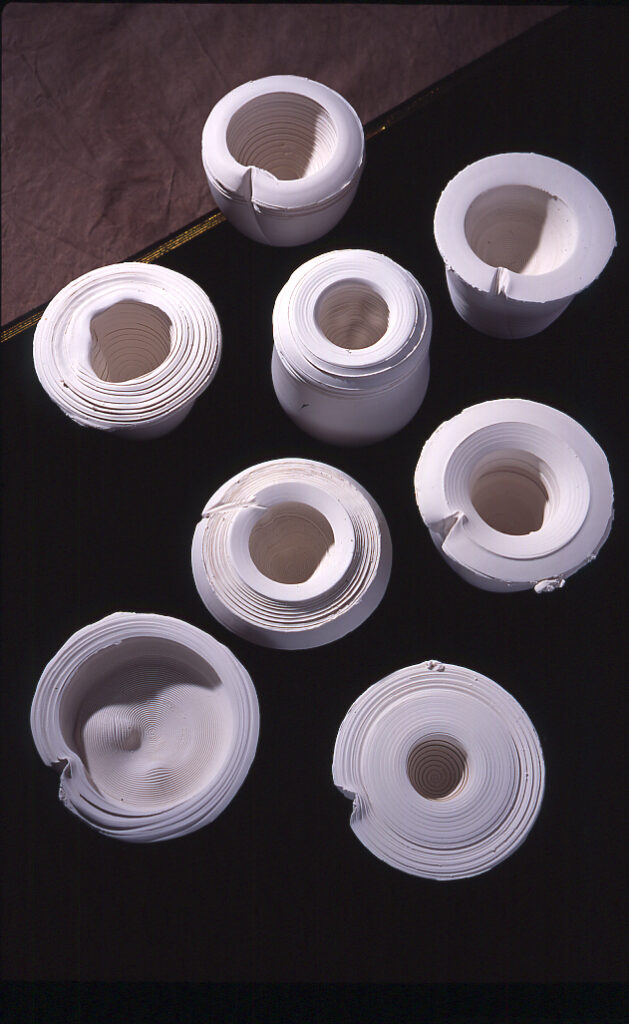
Catalogue essay
Porcelain a material of precision and wonder
Just occasionally in the history of material culture, a novel substance materializes, that is so extra-ordinary, that the people manufacturing and using it, talk of it as an entity, as if it is animate. In the history of civilization, porcelain is one that fits these criteria. And, if it can be said that ceramics struggles to break its material chains then the qualities that porcelain possesses are often those that come to mind in the artistic striving to escape the muddiness of the earthbound. The properties of porcelain actually lie somewhere between those of pottery and glass, and when a maker uses porcelain there is always a compromise generated by its materiality. It is a combination of refractory clay and melting rocks, and these are qualities that make it notoriously problematic to handle and fire. The dilemma for the potter is that the kiln must be hot enough to sinter the silicates to create a translucent solid, but this temperature is also sufficient to deform the precise, fine shapes that porcelain allows, as the body melts. For us potters this seems a risk worth taking, but it does mean that loss and failure are an intimate part of the porcelain artist’s experience.
The Chinese have been manufacturing porcelain from before the time of Christ. When news of this extraordinary material first appeared in the West in the Middle Ages, it was met with incredulity – a substance so white and pure that appeared from the brown of the Earth; somehow it had escaped the contamination with iron that composes nearly 32% of the mass of our planet. Porcelain formed the basis of highly lucrative trade with China, so information was sought by any means possible to get that knowledge. From the time it was first traded with the West, the desire for porcelain was so extreme that even armies were exchanged for some green (Celadon) bowls – Augustus the Strong in Dresden bartered a battalion of soldiers for 151 pots. Knowledge about its manufacture was completely secret yet brought sporadically by missionaries. The essential progress depends on an apocryphal story: at the start of the Enlightenment, the alchemist Böttger was imprisoned for daring to suggest that he could transmute base lead into gold; instead he discovered the equally remarkable feat of creating a white clay at Meissen; this became the calling card of Augustus. In his land this new translucent, material was used essentially in the production of figurines. It soon found its application also in the production of tableware, and refined decorative pots.
This exhibition continues that fascination and focuses on the vessel; vessel is a term which has come to imply a conceptual, often self-referential way of looking at pots that have traded function for a symbolic language through which contemporary clay artists use the traditional grammar of containment to speak of new concerns. These exhibitors endow their pots with a significance beyond the normal associations of utility and decoration, by utilizing the embodied narratives of our material tradition in a more expressive way. When these vessels are made of porcelain they are able to speak through its material character: whiteness, thinness, hardness, a resonant ring when struck and possibilities of translucence.
Many of these technical difficulties are manipulated by the creators featured in this exhibition to metaphoric advantage: thus, for instance, the fineness of body that is possible with advanced technical skill becomes a cipher for fragility; in other instances one can detect an aura of preciousness, that is conveyed by the difficulty and rarity of manufacture. Other artists specifically deny the accepted tropes of porcelain and make thick, gravity-lead objects.
The modes of manufacture are also significant in determining the meaning of the works. Some of the makers featured here use the potter’s wheel to make their work – it is a mode of making that inscribes a symmetry/stillness/regularity on the work, and references the historic traditions of the Oriental masters of the technique. There are also more abstracted works that aspire to the condition of sculpture. Then, within this wide survey of contemporary work there are also makers who appropriate the methods of mass-production, using plaster moulds to make individual statement. Most artists work in series – making multiple iterations of a piece; sometimes those works are grouped as a unitary statement, and a new significance can be drawn form the experience by the audience experiencing the pieces not merely as conjunct objects in an exhibition but juxtaposed in an installation of multiple objects.
The exhibition will tour to a number of Flemish cultural centres and then to Dubi (in the Czech Republic) and to Gmunden (in Austria). This permits a didactic dimension to be planned into the new installations of the show: the best students selected from the art academies in the cities we shall visit will be invited to respond to the works in the exhibition. Thus the student work will be informed by pieces in the exhibition and interpreted through their own languages of making. These student responses will be juxtaposed with the master-works to provide a dialogue of the new with the established. To further this educational remit this exhibition will also be linked to a number of lectures and workshops that will be held in the Cultural Centres and in Atelier Circle 2.
Dr. David Jones. September 2016